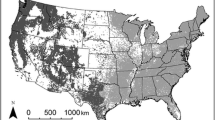Abstract
A prerequisite to sustaining ecosystems is the inventory and classification of landscape structure and composition. Ecological classification and mapping involves the delineation of landscapes into easily recognizable units. Topography, soils, vegetation, physical landscape form, and successional pathways are delineation criteria commonly used.
Damman (1967) developed a forest type classification system for Newfoundland using vegetation, soil and landforms as the defining criteria. Damman's forest types were used in combination with mensurational data to assign forest types to timber volume productivity classes. Since each of the Damman forest types is associated with characteristic soils, parent materials, moisture regime and topographic position, the mapping units are similar to Canada Land Inventory (CLI) mapping units. Field work to confirm the correlation between Damman forest types and CLI capability classes was initiated in 1993. CLI maps were recoded in 1994 and Damman forest types were determined; resulting ecosystem-based maps provide a common framework to assess forestry/wildlife interactions in an ecosystem planning process.
Similar content being viewed by others
References
Damman, A.W.H.: 1967, ‘The forest vegetation of western Newfoundland and site, degradation associated with vegetation change’, Ph.D. Thesis, Univ. of Michigan, Ann Arbor, Michigan, 319 pp.
Delaney, B.B.: 1974, ‘Land capability classification for forestry in Newfoundland’, Newfoundland Forestry Service, Dep. Forestry and Agriculture, 103 pp.
Everitt, R., Hessburg, P., Jensen, M. and Bormann, B.: 1994, ‘Volume 1: Executive Summary: Eastside Forest Ecosystem Health Assessment’, 61 pp.
MeadesW. and MooresL.: 1989, ‘Forest site classification manual: a field guide to the Damman Forest Types of Newfoundland’, Canadian Forest Service, Newfoundland and Labrador Region, St John's, Newfoundland, 285 pp.
MeadesW. and RobertsB.A.: 1992, ‘A review of forest site classification activities in Newfoundland and Labrador’, For. Chron. 68, 25–33.
RaceyG.D.: 1993, ‘Forest ecosystem classification data for non-timber values’, in: A.J.Kayll (ed.), Forest Planning, The Leading Edgé, Ont. Forestry Research Committee Symposium, Oct. 30–31, 1991, North Bay, Ont., Lakehead Univ., Thunder Bay, Ontario, pp. 138–144.
SimsR.A., BowlingC., BaldwinK. and TowillB.: 1993, ‘Forest ecosystem classification systems in Ontario’, in: A.J.Kayll (ed.), Forest Planning, The Leading Edge, Ont. Forestry Research Committee Symposium, Oct. 30–31, 1991 North Bay, Ont., Lakehead Univ., Thunder Bay, Ontario, pp. 114–128.
ThomasJ.W. and TelferE.S.: 1981, ‘An ecosystem approach to integrated timber and wildlife habitat management’, Trans. North Amer. Wild. Conf. 46, 473–487.
ZonneveldI.S.: 1989, ‘The land unit—a fundamental concept in landscape ecology, and its applications’, Landsc. Ecol. 3(2), 67–86.
Author information
Authors and Affiliations
Rights and permissions
About this article
Cite this article
Moores, L.J., Pittman, B. & Kitchen, G. Forest ecological classification and mapping: Their application for ecosystem management in Newfoundland. Environ Monit Assess 39, 571–577 (1996). https://doi.org/10.1007/BF00396169
Issue Date:
DOI: https://doi.org/10.1007/BF00396169




